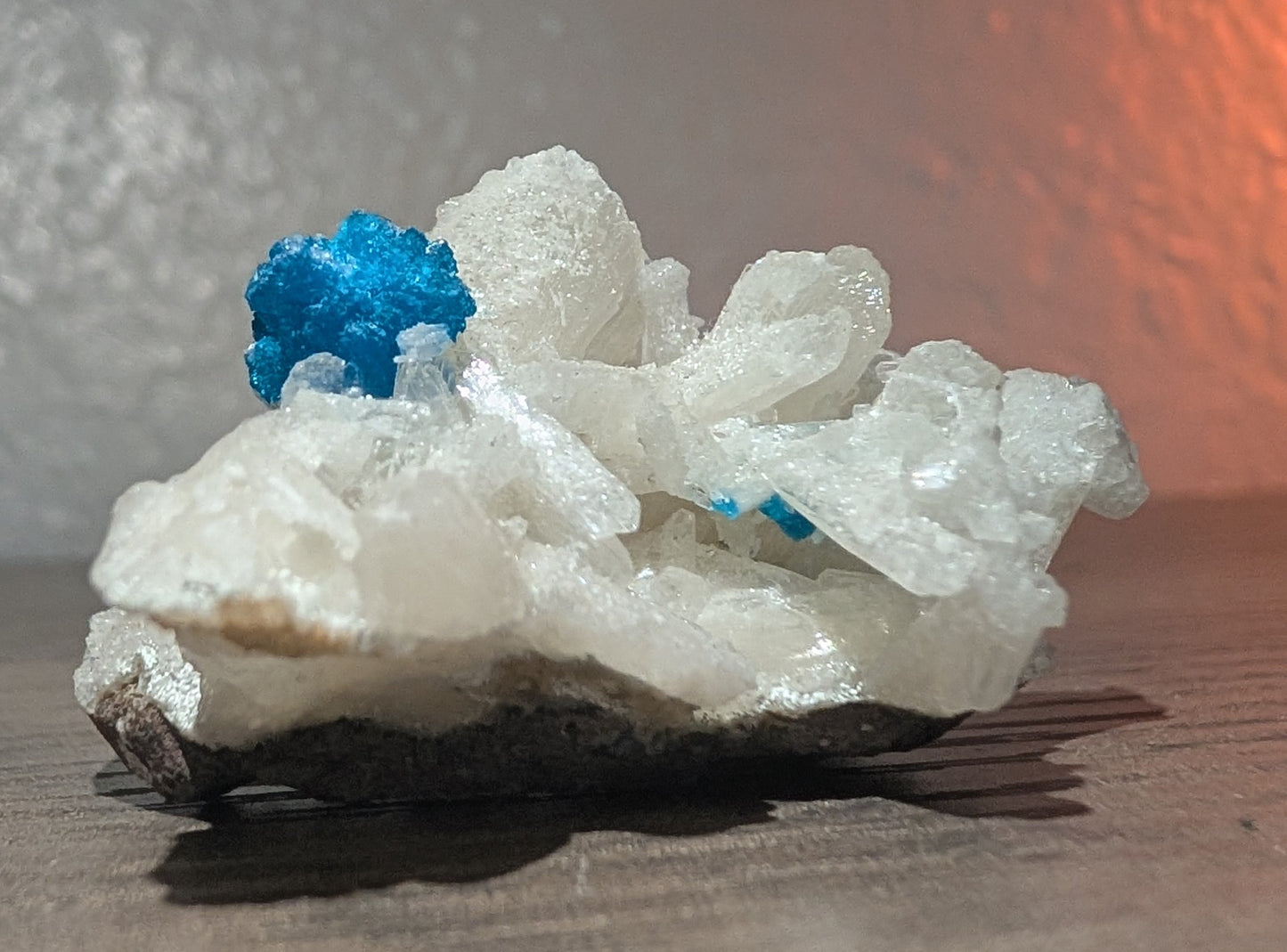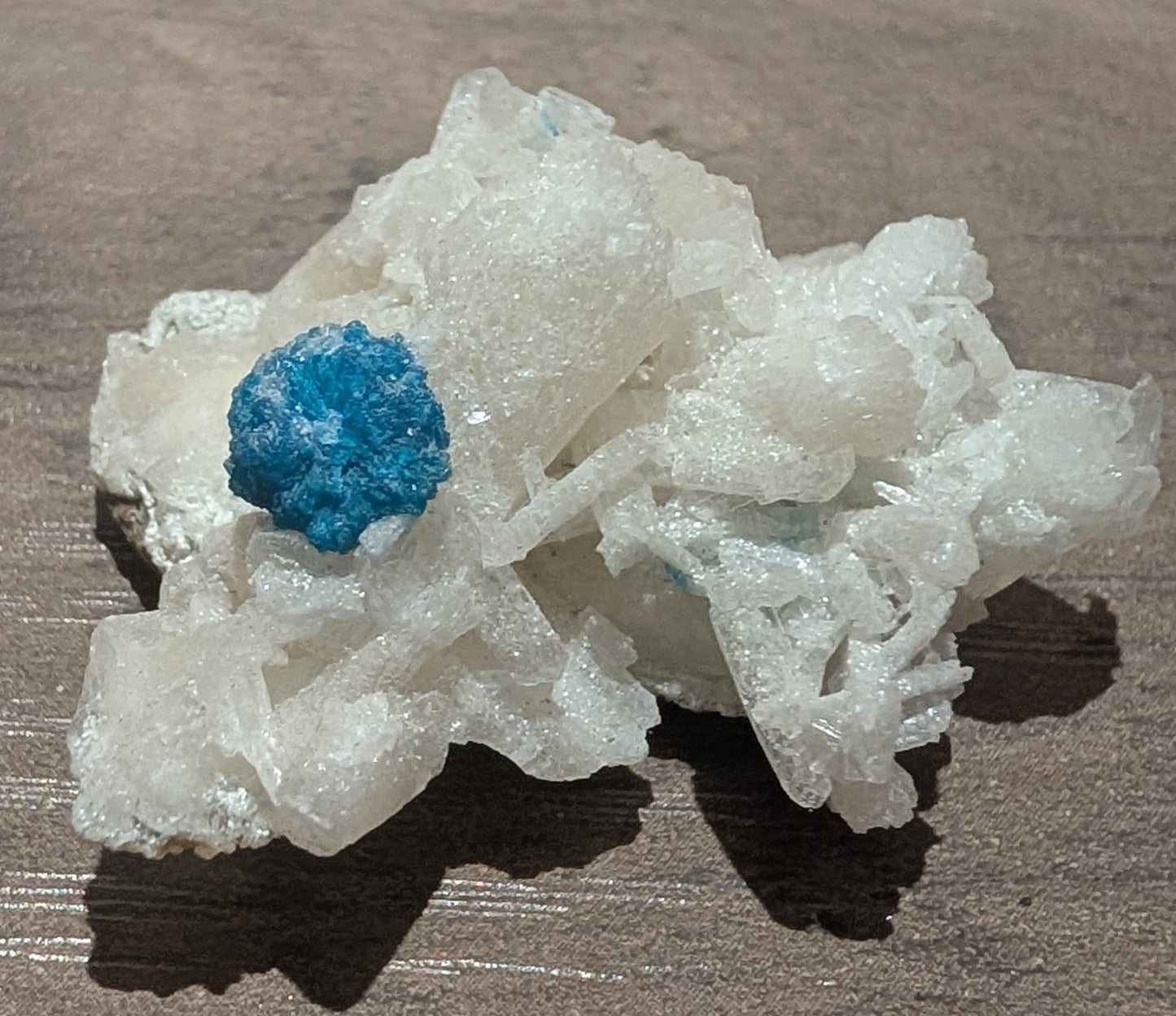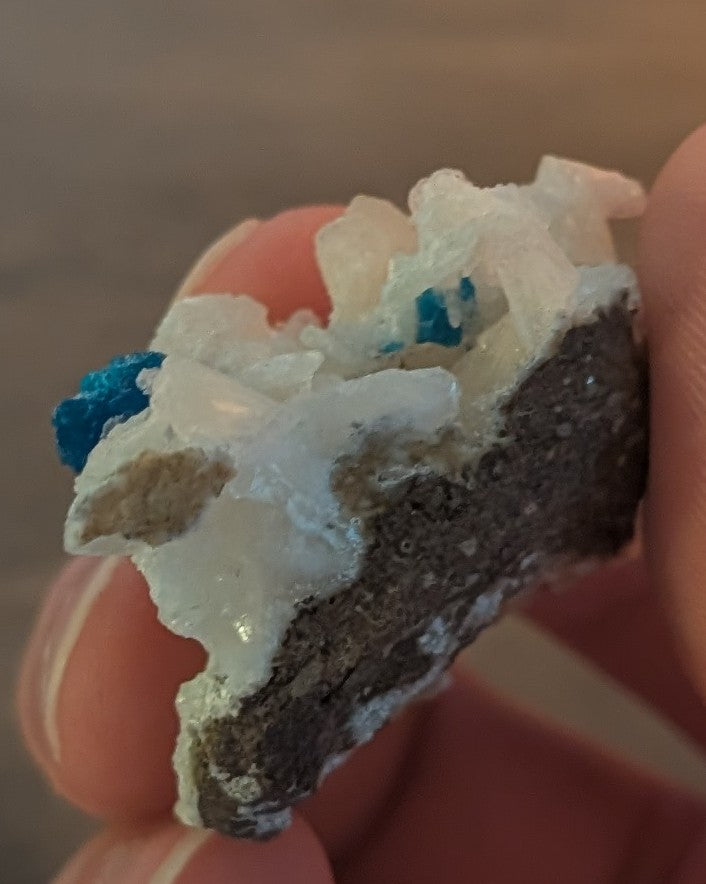Auglocqnuk
Cavansite on Stilbite
Cavansite on Stilbite
Couldn't load pickup availability
Cavansite on stilbite is a striking mineral specimen characterized by vibrant blue cavansite crystals growing on a matrix of the white or pastel-colored zeolite mineral stilbite. This association is one of the most common and visually appealing pairings for cavansite, often found in the Deccan Traps region of western India, particularly near Pune. The cavansite typically forms in small, radiating acicular prismatic crystals that aggregate into spherulitic rosettes, sometimes reaching a few centimeters in size. These rosettes are often found within cavities or vesicles in basaltic rocks, which were formed during ancient volcanic activity.
The formation of cavansite on stilbite is a result of specific geological processes. It begins with volcanic eruptions that produce basalt, a common igneous rock. As the lava cools, trapped gases create voids or vesicles within the rock. Over time, hydrothermal fluids rich in dissolved minerals, including calcium, vanadium, and silicon, percolate through these cavities. The introduction of these elements, particularly vanadium, triggers the crystallization of cavansite, which belongs to the phyllosilicate group of minerals. Simultaneously, stilbite, another zeolite mineral, also crystallizes from these fluids, often forming the matrix upon which the cavansite grows. The specific conditions of temperature, pressure, and chemical composition determine the final characteristics of the specimen.
What makes cavansite on stilbite unique is its combination of intense color and delicate crystal structure. Cavansite is renowned for its brilliant sky-blue to greenish-blue hue, a color directly attributed to the presence of vanadium ions within its chemical structure. This vivid blue color is highly distinctive and contributes significantly to its appeal as a collector's item. The mineral is relatively soft, with a Mohs hardness of 3 to 4, making it brittle and easily damaged, which necessitates careful handling. Its crystal habit is typically orthorhombic, and it often exhibits a vitreous to pearly luster. The association with stilbite is a key identifier, as cavansite is frequently found in this specific geological environment, and the contrast between the blue cavansite and the white or pastel stilbite matrix creates a visually stunning specimen. While cavansite is a rare mineral, with its primary occurrences being in India, New Zealand, Brazil, and the United States (Oregon), the specimens from Pune, India, are particularly prized for their quality and size.
How do cavansite and pentagonite differ?
Cavansite and pentagonite are dimorphs, meaning they share the same chemical composition, Ca(V⁴⁺O)Si₄O₁₀·4H₂O, and are both calcium vanadium phyllosilicates with a vibrant blue color due to the presence of vanadium in the +4 oxidation state. They crystallize in the orthorhombic system and are found in similar geological environments, primarily within the Deccan Traps of India and a few other locations like Oregon, USA. Despite their similarities, they differ significantly in their crystal structure, physical appearance, and formation conditions.
The most notable difference lies in their crystal habit and morphology. Cavansite typically forms spherulitic rosettes, which are compact, ball-like clusters of short, blunt, needle-like crystals. In contrast, pentagonite also forms from spherulitic rosettes but grows into distinct, individual, elongated prismatic crystals with pointed terminations that can extend up to several centimeters in length. These elongated crystals are often described as acicular and can exhibit a characteristic five-branched, pentagon-like cyclic twinning, which is a key identifier for pentagonite. This twinning is not observed in cavansite.
Their physical properties also differ. Pentagonite generally exhibits a deeper, more intense ultramarine blue color compared to the brighter, teal-blue hue of cavansite. The structural differences between the two minerals are profound. Cavansite has a more compact structure with 8-membered rings of SiO₄ tetrahedra joined by 4-membered rings, and its calcium atoms are coordinated by eight oxygen atoms, four from silicate sheets and four from water molecules. Pentagonite has 6-membered rings of SiO₄ tetrahedra, and its calcium atoms are coordinated by only seven oxygen atoms, with one water molecule hydrogen-bonded to other water molecules and silicate oxygen atoms. This structural difference results in cavansite having a lower ground-state energy and a slightly smaller volume (about 2.7% less) than pentagonite.
These structural and energetic differences explain their relative rarity. Cavansite is more common and is considered a low-temperature form, while pentagonite is rarer and is thought to form under higher-temperature conditions. Theoretical studies suggest that the lower energy state of cavansite makes it the more stable phase under typical conditions, and the probability of pentagonite formation is very low at temperatures below 650K. The water molecules in cavansite are also less tightly bound than those in pentagonite, making them easier to remove, which may influence their stability and formation.
Due to their visual similarity, misidentification is common in the mineral market, and the term "pentagonite" is sometimes used abusively to justify higher prices for specimens that are actually cavansite. Without specialized analysis, such as X-ray diffraction, it is impossible to definitively distinguish between the two based on appearance alone.
Share






